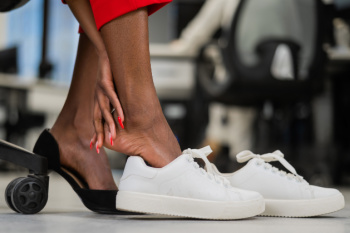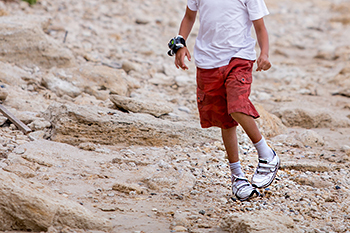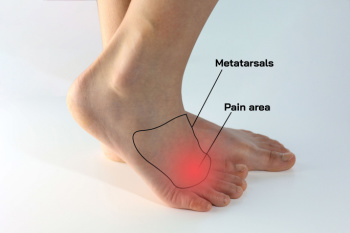Items filtered by date: August 2024
Common Foot and Ankle Injuries in Golf

Golf, though less intense than other sports, can still lead to foot and ankle injuries due to repetitive motions and uneven terrain. Common foot issues among golfers include ankle sprains from uneven surfaces or sudden movements during swings. Plantar fasciitis may develop from prolonged standing and walking, causing heel pain. Stress fractures can occur from overuse and excessive impact on the feet. To prevent these injuries, golfers should wear supportive, well-fitted golf shoes that offer good traction and cushioning. Proper warm-up and stretching exercises, focusing on the feet and ankles, can help prepare the body for the game. Additionally, paying attention to the course's condition and avoiding rough or uneven areas can minimize injury risk. Regular foot strengthening and flexibility exercises can also enhance resilience and prevent common golf-related foot and ankle problems. If you have endured a foot or ankle injury while playing golf, it is suggested that you contact a podiatrist who can treat various foot conditions and educate you on proper injury prevention techniques while playing golf.
Sports related foot and ankle injuries require proper treatment before players can go back to their regular routines. For more information, contact Lauryn Smith-Winton, DPM of S.W. Podiatry Group. Our doctor can provide the care you need to keep you pain-free and on your feet.
Sports Related Foot and Ankle Injuries
Foot and ankle injuries are a common occurrence when it comes to athletes of any sport. While many athletes dismiss the initial aches and pains, the truth is that ignoring potential foot and ankle injuries can lead to serious problems. As athletes continue to place pressure and strain the area further, a mild injury can turn into something as serious as a rupture and may lead to a permanent disability. There are many factors that contribute to sports related foot and ankle injuries, which include failure to warm up properly, not providing support or wearing bad footwear. Common injuries and conditions athletes face, including:
- Plantar Fasciitis
- Plantar Fasciosis
- Achilles Tendinitis
- Achilles Tendon Rupture
- Ankle Sprains
Sports related injuries are commonly treated using the RICE method. This includes rest, applying ice to the injured area, compression and elevating the ankle. More serious sprains and injuries may require surgery, which could include arthroscopic and reconstructive surgery. Rehabilitation and therapy may also be required in order to get any recovering athlete to become fully functional again. Any unusual aches and pains an athlete sustains must be evaluated by a licensed, reputable medical professional.
If you have any questions please feel free to contact our office located in Waldorf, MD . We offer the newest diagnostic and treatment technologies for all your foot and ankle needs.
Diagnosing Heel Pain

The heel, the largest bone in the foot, plays an important role in walking and weight-bearing, absorbing shock and providing stability. Heel pain is a common issue with various causes. Plantar fasciitis, characterized by inflammation of the plantar fascia, leads to sharp, morning heel pain. Heel spurs, which are calcium deposits on the heel bone, can cause discomfort with prolonged standing or walking. Sever's disease, prevalent in growing children, results from inflammation of the heel growth plate. These conditions necessitate professional assessment. If you or a family member suffers from heel pain, it is suggested that you consult a podiatrist for a proper diagnosis, identify the underlying cause, and recommend appropriate treatments.
Many people suffer from bouts of heel pain. For more information, contact Lauryn Smith-Winton, DPM of S.W. Podiatry Group. Our doctor can provide the care you need to keep you pain-free and on your feet.
Causes of Heel Pain
Heel pain is often associated with plantar fasciitis. The plantar fascia is a band of tissues that extends along the bottom of the foot. A rip or tear in this ligament can cause inflammation of the tissue.
Achilles tendonitis is another cause of heel pain. Inflammation of the Achilles tendon will cause pain from fractures and muscle tearing. Lack of flexibility is also another symptom.
Heel spurs are another cause of pain. When the tissues of the plantar fascia undergo a great deal of stress, it can lead to ligament separation from the heel bone, causing heel spurs.
Why Might Heel Pain Occur?
- Wearing ill-fitting shoes
- Wearing non-supportive shoes
- Weight change
- Excessive running
Treatments
Heel pain should be treated as soon as possible for immediate results. Keeping your feet in a stress-free environment will help. If you suffer from Achilles tendonitis or plantar fasciitis, applying ice will reduce the swelling. Stretching before an exercise like running will help the muscles. Using all these tips will help make heel pain a condition of the past.
If you have any questions please contact our office located in Waldorf, MD . We offer the newest diagnostic and treatment technologies for all your foot and ankle needs.
Clubfoot and the Ponseti Method for Treatment

Clubfoot is a congenital foot condition where one or both feet are abnormally rotated inward and downward. This condition, present at birth, can restrict a child's ability to walk and may lead to mobility issues if left untreated. The Ponseti method is a widely recognized treatment approach for clubfoot, focusing on gentle manipulation and casting to correct the foot's position. This method involves a series of weekly castings to gradually realign the foot, followed by the use of a brace to maintain the corrected position and prevent recurrence. The Ponseti method, a non-surgical approach, has a high success rate and offers a significant improvement in foot function and appearance. If your child has been born with clubfoot, it is strongly suggested that you include a podiatrist on your healthcare team for optimal correction results.
Congenital foot problems require immediate attention to avoid future complications. If you have any concerns, contact Lauryn Smith-Winton, DPM of S.W. Podiatry Group. Our doctor can provide the care you need to keep you pain-free and on your feet.
Congenital foot problems are deformities affecting the feet, toes, and/or ankles that children are born with. Some of these conditions have a genetic cause while others just happen. Some specific foot ailments that children may be born with include clubfeet, polydactyly/macrodactyly, and cleft foot. There are several other foot anomalies that can occur congenitally. What all of these conditions have in common is that a child may experience difficulty walking or performing everyday activities, as well as trouble finding footwear that fits their foot deformity. Some of these conditions are more serious than others. Consulting with a podiatrist as early as possible will help in properly diagnosing a child’s foot condition while getting the necessary treatment underway.
What are Causes of Congenital Foot Problem?
A congenital foot problem is one that happens to a child at birth. These conditions can be caused by a genetic predisposition, developmental or positional abnormalities during gestation, or with no known cause.
What are Symptoms of Congenital Foot Problems?
Symptoms vary by the congenital condition. Symptoms may consist of the following:
- Clubfoot, where tendons are shortened, bones are shaped differently, and the Achilles tendon is tight, causing the foot to point in and down. It is also possible for the soles of the feet to face each other.
- Polydactyly, which usually consists of a nubbin or small lump of tissue without a bone, a toe that is partially formed but has no joints, or an extra toe.
- Vertical talus, where the talus bone forms in the wrong position causing other bones in the foot to line up improperly, the front of the foot to point up, and the bottom of the foot to stiffen, with no arch, and to curve out.
- Tarsal coalition, when there is an abnormal connection of two or more bones in the foot leading to severe, rigid flatfoot.
- Cleft foot, where there are missing toes, a V-shaped cleft, and other anatomical differences.
- Macrodactyly, when the toes are abnormally large due to overgrowth of the underlying bone or soft tissue.
Treatment and Prevention
While there is nothing one can do to prevent congenital foot problems, raising awareness and receiving neonatal screenings are important. Early detection by taking your child to a podiatrist leads to the best outcome possible.
If you have any questions please feel free to contact our office located in Waldorf, MD . We offer the newest diagnostic tools and technology to treat your foot and ankle needs.
Definition and Relief Methods of Morton’s Neuroma

Morton's neuroma is a compressive neuropathy of the forefoot interdigital nerve, that results in a thickening of tissue surrounding the nerves leading to the toes. It typically affects the nerves between the third and fourth toes. This condition causes pain, numbness, or a burning sensation in the ball of the foot, often worsened by wearing narrow shoes or high heels that squeeze the toes together. Relief methods focus on alleviating pressure on the affected nerve, such as wearing shoes with a wide toe box to reduce compression. Padded inserts or orthotics can help to distribute weight evenly and support the arch, relieving strain on the forefoot. Massaging the area can reduce inflammation and provide temporary relief. In severe cases, corticosteroid injections or surgical removal of the neuroma may be considered to alleviate persistent symptoms and restore comfort and function to the foot. If you have pain in this part of your foot, it is suggested that you promptly schedule an appointment with a podiatrist who can successfully diagnose and treat Morton’s neuroma.
Morton’s neuroma is a very uncomfortable condition to live with. If you think you have Morton’s neuroma, contact Lauryn Smith-Winton, DPM of S.W. Podiatry Group. Our doctor will attend to all of your foot care needs and answer any of your related questions.
Morton’s Neuroma
Morton's neuroma is a painful foot condition that commonly affects the areas between the second and third or third and fourth toe, although other areas of the foot are also susceptible. Morton’s neuroma is caused by an inflamed nerve in the foot that is being squeezed and aggravated by surrounding bones.
What Increases the Chances of Having Morton’s Neuroma?
- Ill-fitting high heels or shoes that add pressure to the toe or foot
- Jogging, running or any sport that involves constant impact to the foot
- Flat feet, bunions, and any other foot deformities
Morton’s neuroma is a very treatable condition. Orthotics and shoe inserts can often be used to alleviate the pain on the forefront of the feet. In more severe cases, corticosteroids can also be prescribed. In order to figure out the best treatment for your neuroma, it’s recommended to seek the care of a podiatrist who can diagnose your condition and provide different treatment options.
If you have any questions, please feel free to contact our office located in Waldorf, MD . We offer the newest diagnostic and treatment technologies for all your foot care needs.
